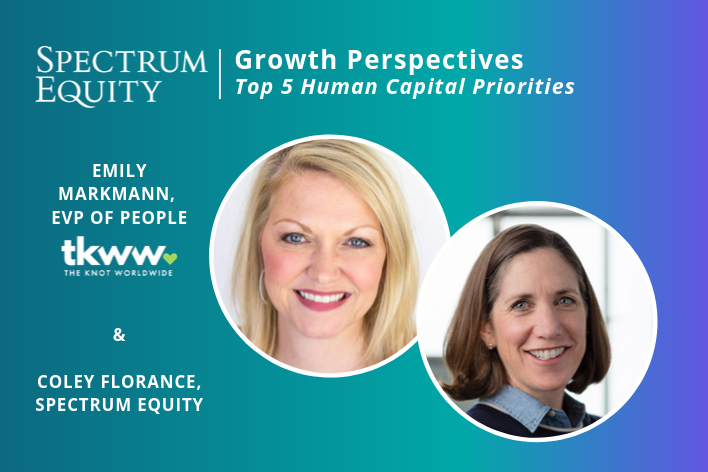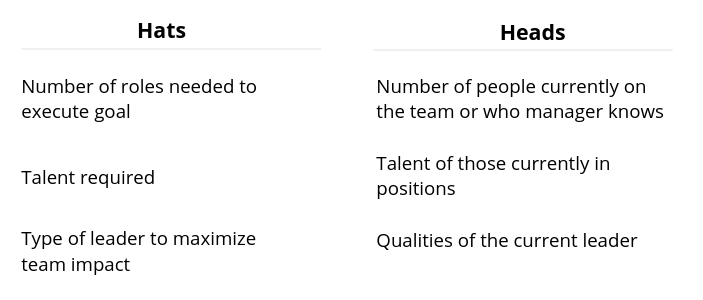
perspectives
Growth Perspectives: Scaling Up and Retaining Talent with TKWW Emily Markmann’s Top Five Human Capital Priorities


In 2012, Spectrum invested in WeddingWire, a global online marketplace connecting consumers with wedding event and creative professionals. Following its 2018 merger with XO Group Inc., the combined entity known today as The Knot Worldwide encompasses a global family of brands that aim to inspire and inform people during life’s most memorable moments.
When Spectrum first partnered with WeddingWire, the company had 140 employees. Seven years after its initial growth investment and the 2018 merger, the company has become the largest global wedding planning company with over 1,700 employees in 15 countries across four continents.
As The Knot Worldwide’s EVP of People, Emily Markmann experienced firsthand how to manage and retain diverse talent across different countries, time zones, and languages during the company’s continued rapid growth. Through the company’s expansion, Emily discovered creative, evidence-based ways to source and hire top talent while managing the resources and goals of a company, including its top resource: its employees. In this edition of Growth Perspectives, Spectrum’s Head of Talent, Coley Florance, recently spoke with Emily about the top five human capital priorities leadership needs to focus on when scaling a company and cultivating talent: lessons that could help a growing organization of any size weather a transition.
Emily Markmann’s Top Five Human Capital Priorities
1. Talent Inventory
Scaling an organization means taking functions, resources, and talent — which may sometimes operate in isolation, yet all have a massive impact — and recognizing that all these elements together advance and substantiate human capital’s role in an organization. This is where human capital can bring a level of serenity and calm to an organization undergoing rapid change. Talent is critical to any organization’s DNA, but when companies grow quickly and things feel chaotic, a fragmented strategy can emerge. You’re hiring like crazy, throwing bodies at projects and initiatives, and losing track of who you have, how many you have, what they’re doing, and where they are. Too often, companies grow so fast that they lose clarity about their own talent inventory and fail to track metrics.
Recommended actions:
- Create a human capital dashboard to reveal the full landscape of talent and teams
- Regularly identify areas of strength and opportunities for improvement
- Use a basic nine-grid perspective to identify high-potentials (Hi-POs)
- Ensure Hi-POs are engaged and in the right roles
2. The Care and Feeding of Hi-Pos
Human capital is very much a marketing function, so it’s useful to look at employees as customers. Like customers, employees have a journey, and it’s important to map the right path for these valued individuals.
Best practices to nurture talent:
- Identify milestones and moments that matter (hiring, onboarding, anniversaries, performance reviews) and ensure positive journey for employees
- Proactively single out Hi-POs within their first six months on the job
- Ensure that leadership development continues even amidst the chaos of growth;
- Map out individuals roles and goals
- Identify stretch opportunities for Hi-POs, like utilizing breakout technologies or initiatives that will drive business
- Include ongoing and regular check-ins with Hi-POs to ask “How are things going? What can we do differently? How can we better engage you?”
Low performers may be in the wrong role or capped out and unable to transition across the organization. Nothing demotivates Hi-POs more than Low-POs. To achieve excellence across an organization, managers need to be honest and tackle Low-PO challenges proactively — not reactively. Sometimes, a high potential employee may be a low performer in the wrong role. Managers need to be flexible about shifting and maximizing talent across their organization. Identify low performers who have potential or a unique skill set, provide them with different assignments, and assess their skills and strengths to get them re-engaged. Remember to not quickly throw out the baby with the bath water but to take an honest look at your low-performers and see what changes can be made to benefit the company.
3. Hats vs. Heads Methodology
It is hard to retrofit somebody into a role. Yet making decisions about who to hire and for what role can be tricky. Too often we see managers choose familiarity, hiring their cousin's girlfriend or their business school classmate. And there will always be employees with immense institutional knowledge and those who have garnered tremendous loyalty, but when making decisions about scaling up, you need to consider the “Hats versus Heads” framework. The hats versus heads methodology helps depersonalize emotions and entanglements, freeing up managers to make objective decisions based on how many actual people are needed to meet the greater goals. Here are some examples:

4. People Leave Bad Managers
You cannot train management too early. Properly training and developing the next generation of managers is crucial for talent retention. Look within your organization to figure out how to train and invest in middle managers as soon as possible because these folks have a high impact on staffing and completing goals.
Since we know that people leave bad managers, creating staffing challenges and turnover, we wanted to change this dynamic. So, The Knot Worldwide created a manager certification program that includes badges of completion and recognition. Certification creates basic tenets that a manager has to operate by that are consistent across the organization while providing managers with a basic tool kit that explains core competencies and role expectations. Middle managers are the front lines, dealing with the employees who are executing against goals, and organizations can use data analytics to measure how managers and teams are doing in order to see where adjustments need to be made.
5. Data
Data plays a key role for any human capital executive supporting leadership teams. In conjunction with the human capital dashboard, companies need a dashboard that tracks business health metrics. If that dashboard is missing people data, a major piece of your business and business health is missing. It’s critical to obtain metrics to develop graphical representations of your talent landscape, which in turn, allows leadership to participate intelligently in meetings and quickly provide informed responses to questions such as "How many people did we hire last year?" or "What's your regrettable voluntary attrition?”
Data does the following:
- Allows leadership to speak intelligently on the fly
- Provides a realistic picture of the company
- Creates a single evidence-based source of truth
- Predicts customer and employee activity
- Explains a surge of departures
- Assesses what average tenure is
- Proactively assesses a company’s employee base
When you have strong people analytics, as a human capital representative, you can then show up to meetings and provide insight and predictive models just as any data scientist would.
A big thanks to Emily for sitting down with us to share her views on cultivating talent and the top human capital priorities to focus on when scaling a company. We have been privileged to have a front row seat to the company’s explosive growth and look forward to all that’s to come from the talented team at The Knot Worldwide.